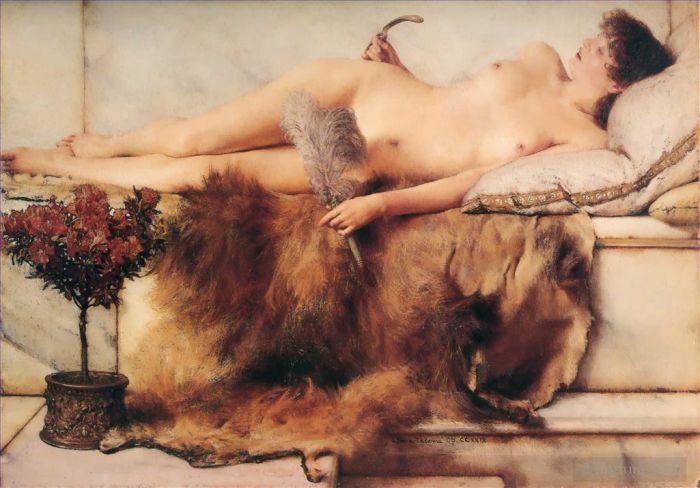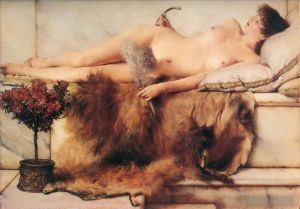In the Tepidarium
Sir Lawrence Alma-Tadema
- Price: Price on Request
- Art Type: Oil Painting
- Size:
- English Comments: 0
- International Comments: 0
- Creating Date:
- Introduction and Works of Sir Lawrence Alma-Tadema >>
Keywords:
Tepidarium
Work Overview
- The Tepidarium
Sir Lawrence Alma-Tadema
Date: 1881
Style: Romanticism
Genre: nude painting (nu)
Oil on panel
24 x 33cm
Alma-Tadema was born in Holland but settled in London, where he achieved great success with his scenes of daily life in ancient times.
The tepidarium was the warm Roman bath. This painting shows a girl holding an ostrich feather and a strigil used for scraping the skin after soaping and oiling it. Alma-Tadema generally contrasted archaeologically accurate detail with aggressively modern figures and attitudes. He was also the most gifted exponent among Victorian painters in rendering exactly textures, surfaces and colours.
This combination of learning and realism proved very disconcerting when applied to the nude. It is surprising that A and F Pears, who owned this work before Leverhulme purchased it in 1916, could ever have considered using it in a soap advertisement, however appropriate for the purpose it may be.
The tepidarium was the warm (tepidus) bathroom of the Roman baths heated by a hypocaust or underfloor heating system. The specialty of a tepidarium is the pleasant feeling of constant radiant heat which directly affects the human body from the walls and floor.
There is an interesting example at Pompeii; this was covered with a semicircular barrel vault, decorated with reliefs in stucco, and round the room a series of square recesses or niches divided from one another by Telamones. The tepidarium in the Roman thermae was the great central hall round which all the other halls were grouped, and which gave the key to the plans of the thermae. It was probably the hall where the bathers first assembled prior to passing through the various hot baths (Caldaria) or taking the cold bath (Frigidarium). The tepidarium was decorated with the richest marbles and mosaics: it received its light through clerestory windows, on the sides, the front and the rear, and would seem to have been the hall in which the finest treasures of art were placed; thus in the thermae of Caracalla, the Farnese Hercules, and the Toro Farnese, the two gladiators, the sarcophagi of green basalt now in the Vatican, and numerous other treasures, were found during the excavations by Paul III in 1546, and transported to the Vatican and the museum at Naples.
- Copyright Statement:
All the reproduction of any forms about this work unauthorized by Singing Palette including images, texts and so on will be deemed to be violating the Copyright Laws.
To cite this webpage, please link back here.
- >> English Comments
- >> Chinese Comments
- >> French Comments
- >> German Comments
- >>Report
- Death of the Pharaohs Firstborn Son
- A Pyrrhic Dance
- Summer Offering Young Girl with Roses
- Between Venus and Bacchus
- A Roman Emperor AD41detail1
- Portrait of Ignacy Jan Paderewski
- Portrait Of Mrs Charles Wyllie
- The Massacre of the Monks of Tamond
- Pandora
- Who is it
- Egyptian juggler
- A Family Group
- The Death of Hippolytus
- A reading from homer detail
- A world of their own
- The Crossing of the River Berizina 1812
- A Hearty Welcome
- In the Temple Opus 1871
- The Flower Market
- A Roman Art Lover2
- The Sculptors Model
- Ask me no more
- In My Studio
- Expectations
- Welcome footsteps
- A Bath An Antique Custom
- A Declaration
- Portrait of a Woman
- Autumn Vintage Festival
- Ave Caesar Io Saturnalia
- Spring Flowers
- Unwelcome Confidences
- The Picture Gallery
- A Roman Emperor
- Boating
- Caracalla and Geta
- The voice of spring
- The Finding of Moses 1904
- Shy
- A votive offering
- A Harvest Festival A Dancing Bacchante at Harvest Time
- Thou Rose of all the Roses
- Portrait of Aime Jules Dalou his Wife and Daughter
- Flora Spring in the Gardens of the Villa Borghese
- The Sculpture Gallery detail
- A Collection of Pictures at the Time of Augustus
- Prose
- A Difference of Opinion
- A Silent Greeting
- Caracalla
- The Potter
- Poetry
- Confidences
- Maria Magdalena
- Golden hour
- Phidias Showing the Frieze of the Parthenon
- A Listner
- Exhausted Maenides after the Dance
- Interrupted
- The Vintage Festival
- Master John Parsons Millet
- A greek woman
- Proclaiming Claudius Emperor
- Flag Of Truce
- Between Hope and Fear
- The Drawing Room at Townshend House
- Venantius Fortunatus Reading His Poems to Radegonda VI
- Portrait Of Miss Laura Theresa Epps
- Strigils and sponges
- Always Welcome
- Drawing Room Holland Park
- Self Portrait
- Pastimes in Ancient Egyupe 300Years Ago
- The Coliseum
- The Roses of Heliogabalus
- Miss Alice Lewis
- Sunshine
- The years at the spring
- Agrippina with the ashes of Germanicus Opus XXXVII
- Interior of Caius Martiuss House
- A reading from homer
- Joseph Overseer of the Pharoahs Granaries
- Tibullus at Delias
- God Speed
- Midday Slumbers
- The Roman Wine Tasters
- Hadrian Visiting a Romano British Pottery
- A Roman Art Lover
- British 18361912A Roman Scribe Writing Dispatches
- On the Road to the Temple of Ceres
- In the Peristyle2
- Faust and Marguerite
- The Baths of Caracalla
- The parting kiss
- Sappho and Alcaeus
- Interior of the Church of San Clemente Rome
- Sculptors in Ancient Rome
- Egyptian Chess Players
- Sir Lawrence From An Absent One
- A Dedication to Bacchus
- Preparation in the Colosseum detail
- Vain Courtship
- Preparation in the Colosseum
- Mrs George Lewis and Her Daughter Elizabeth
- Dolce Far Niente
- Loves Jewelled Fetter
- A Picture Gallery
- When Flowers Return
- Courtship
- A Favourite Custom
- Maurice Sens
- The Favourite Poet
- Tarquinius Superbus
- Unconscious Rivals
- The Sculpture Gallery
- Architecture in Ancient Rome
- Hopeful
- Portrait of the Singer George Henschel
- After the audience
- Cherries
- Sir Lawrence The Soldier Of Marathon
- Hero 1898
- The Triumph of Titus
- A Prize For The Artists Corps
- Antony and Cleopatra
- Ninetyfour in the Shade
- The Education of the Children of Clovis
- The Frigidarium
- Resting
- Silver Favourites
- Entrance to a roman theatre
- Gallo Roman Women
- An exedra
- Sir Lawrence An Audience
- Loves Votaries
- Not at home
- The Siesta
- A sculpture gallery
- A Street Altar
- Pottery painting
- The Discourse
- Courtship the Proposal
- Lawrence Bacchanale 1871
- Under the Roof of Blue Ionian Weather
- Xanthe and Phaon
- Leaving Church in the Fifteenth Century
- Summer Offering
- Water Pets
- A Birth Chamber
- Portrait of Anna Alma Tadema
- In the Tepidarium
- Pleading
- The Soldier of Marathon
- This is our Corner Laurense and Anna Alma Tadema
- Whispering Noon
- Catullus at Lesbias
- The Way to the Temple
- The Honeymoon
- The Conversion Of Paula By Saint Jerome
- An earthly paradise
- Preparations for the Festivities
- Promise of spring
- Comparisons
- An Oleander
- A kiss
- The Family Group
- My Studio
- The Epps Family Screen
- In the Time of Constantine
- Lesbia Weeping over a Sparrow









 Singing Palette
Singing Palette